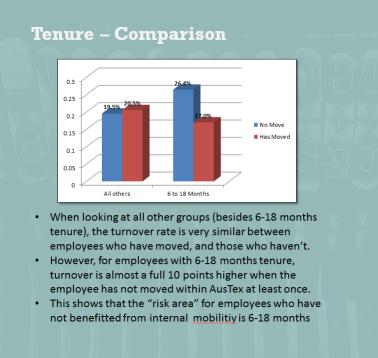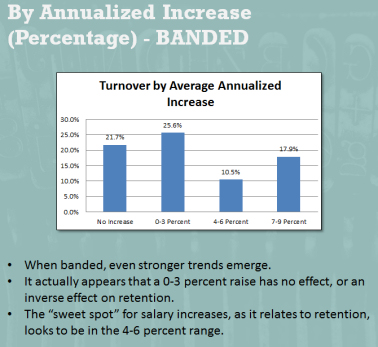
The Basics
The employee retention playbook is your end-all be-all guide to understanding, predicting, and reducing employee turnover at your organization. The playbook contains information and metrics that are based off of your data. We are not making assumptions based off of your location, city, or what our other clients do. Everything in the playbook is custom-built based off of your employee history, and which factors influence turnover at your company.
What's In It?
The playbook contains numerous metrics, tailored to your organization and data history, that answer immediate and value-creating HR questions, including:
- Employee
Career Retention Guide: (as pictured above). For each of
your key positions or functions, we will provide you with a guide that
shows your best method to reduce turnover for employees, based on
tenure. For example, in the above, we see that The only strong
inflection point where compensation reduces turnover is around the
12-month mark. At all other points, engagement or mobility have a
higher impact on retention. Companies without a data-backed strategy
will often throw money at an employee to keep them, when in fact,
that's not the most effective retention tool they can use..
- Turnover Root Cause Findings: Our consultants comb through your historical employee data, including HRIS, ATS, performance, and more. Using our enterprise technology and data warehouse, we carefully analyze historical correlation and trends to understand what employee traits and activities create turnover. Here are some examples of the types of findings we discover:
- At one client, we found that a manager change increases turnover risk over 300% for the employees.
- At the same client, we discovered that an annual increase below three percent has the same retention effect as no raise at all. Raises in the 4-6 percent range reduced turnover by nearly 30%. And after 6 percent, additional increases had negligible impact on retention. This allowed them to increase retention while saving money by targeting key employees with strategic, correct increases.
- At another client, we discovered that an employee mobility event (transfer or promotion) significantly reduces turnover.
- We found that there are several key jobs where retention of employees is much higher for employees hired into that job internally, vs. externally. We also found the reverse, jobs where external hires had higher retention rates. This allowed the company to leverage mobility and recruiting more strategically to reduce turnover.
- We will also make discoveries based on geography, job function, tenure, performance ratings, and any other data points you can provide us within your talent systems
Example Findings Output
| f |  |
 |


